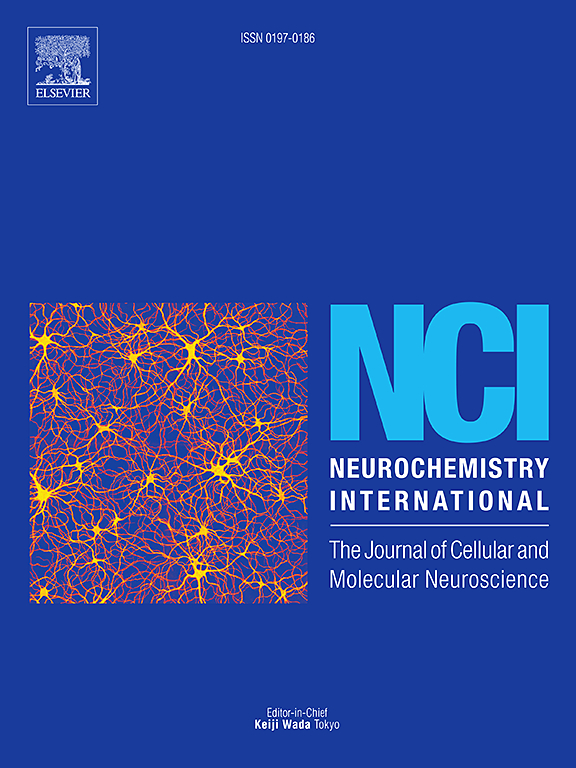Mechanism of Tau protein incorporation into exosomes via cooperative recognition of KFERQ-like motifs by LAMP2A and HSP70
IF 4
3区 医学
Q2 BIOCHEMISTRY & MOLECULAR BIOLOGY
引用次数: 0
Abstract
Aggregates of the tau protein is a well-known hallmark of Alzheimer's disease (AD) and other Tauopathies, such as Frontotemporal dementia (FTD). Tau can be propagated between nerve cells or brain areas, similar as 'seed'. As a member of small extracellular vesicles, exosomes may act as one of the most important 'seeding machines', disseminating toxic tau and phosphorylated tau proteins between cells and thereby amplifying their neurotoxic effects. Therefore, exploring the underlying mechanisms of Tau loading into exosomes is of great importance. In this study, human P301L tau transfections were established in SH-SY5Y cells (SY5Y-EGFP-TauP301L cells). The content of membrane protein LAMP2A and HSP70 proteins was significantly increased in the SY5Y-EGFP-Tau P301L cells compared to control group. Tau containing KFERQ-like motifs pentapeptide interact with LAMP2A and HSP70, forming a multi-protein complex, which can be loaded into a subpopulation of exosomes. Moreover, knockout of LAMP2A significantly reduced the content of Tau protein in exosomes obtained from SY5Y-EGFP-Tau P301L cells. Thus, exosome-mediated secretion of tau protein may depend on the formation of multi-protein (KFERQ-like motif pentapeptide in tau,LAMP2A and HSP70) complex. These findings revealed the presence of a novel mechanism by which release of tau through exosome secretion pathway and that LAMP2A may play an important role in the regulation of exosome-mediated secretion of tau, which may become a potential therapeutic target for AD or other Tauopathies.
通过LAMP2A和HSP70共同识别kferq样基序,Tau蛋白进入外泌体的机制。
众所周知,tau蛋白的聚集是阿尔茨海默病(AD)和其他tau病(如额颞叶痴呆(FTD))的标志。Tau蛋白可以在神经细胞或大脑区域之间传播,类似于“种子”。作为细胞外小泡的一员,外泌体可能是最重要的“播种机器”之一,在细胞之间传播有毒的tau和磷酸化的tau蛋白,从而放大它们的神经毒性作用。因此,探索Tau蛋白装载到外泌体的潜在机制非常重要。本研究在SH-SY5Y细胞(SY5Y-EGFP-TauP301L细胞)中建立了人P301L tau转染。与对照组相比,SY5Y-EGFP-Tau P301L细胞中膜蛋白LAMP2A和HSP70的含量显著升高。含有kferq样基序五肽的Tau与LAMP2A和HSP70相互作用,形成多蛋白复合物,可装载到外泌体亚群中。此外,敲除LAMP2A显著降低了SY5Y-EGFP-Tau P301L细胞外泌体中Tau蛋白的含量。因此,外泌体介导的tau蛋白分泌可能依赖于多蛋白复合物(tau、LAMP2A和HSP70中的kferq样基序五肽)的形成。这些发现揭示了一种通过外泌体分泌途径释放tau的新机制,并且LAMP2A可能在调节外泌体介导的tau分泌中发挥重要作用,这可能成为AD或其他tau病的潜在治疗靶点。
本文章由计算机程序翻译,如有差异,请以英文原文为准。
求助全文
约1分钟内获得全文
求助全文
来源期刊

Neurochemistry international
医学-神经科学
CiteScore
8.40
自引率
2.40%
发文量
128
审稿时长
37 days
期刊介绍:
Neurochemistry International is devoted to the rapid publication of outstanding original articles and timely reviews in neurochemistry. Manuscripts on a broad range of topics will be considered, including molecular and cellular neurochemistry, neuropharmacology and genetic aspects of CNS function, neuroimmunology, metabolism as well as the neurochemistry of neurological and psychiatric disorders of the CNS.
 求助内容:
求助内容: 应助结果提醒方式:
应助结果提醒方式:


